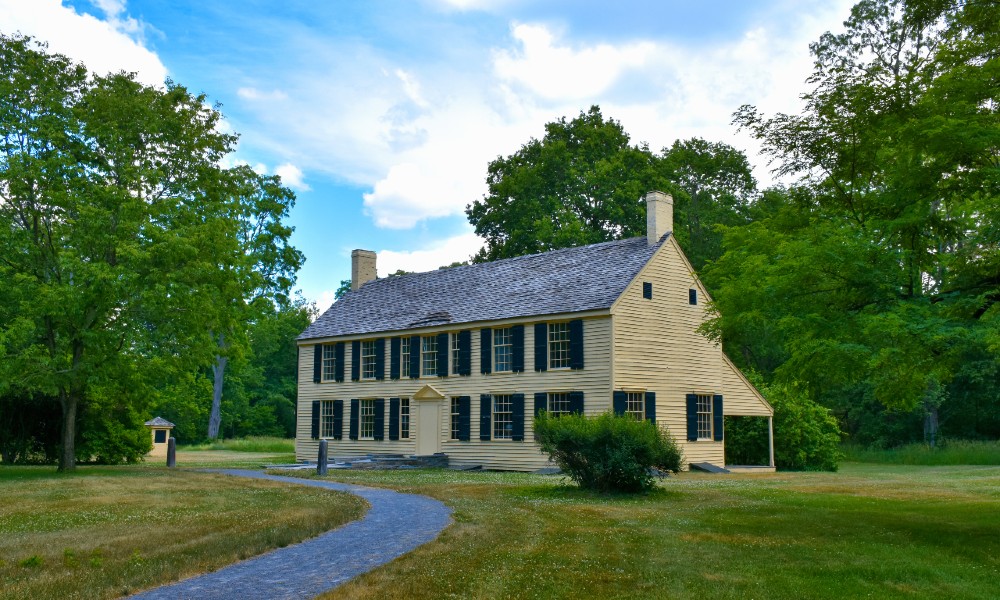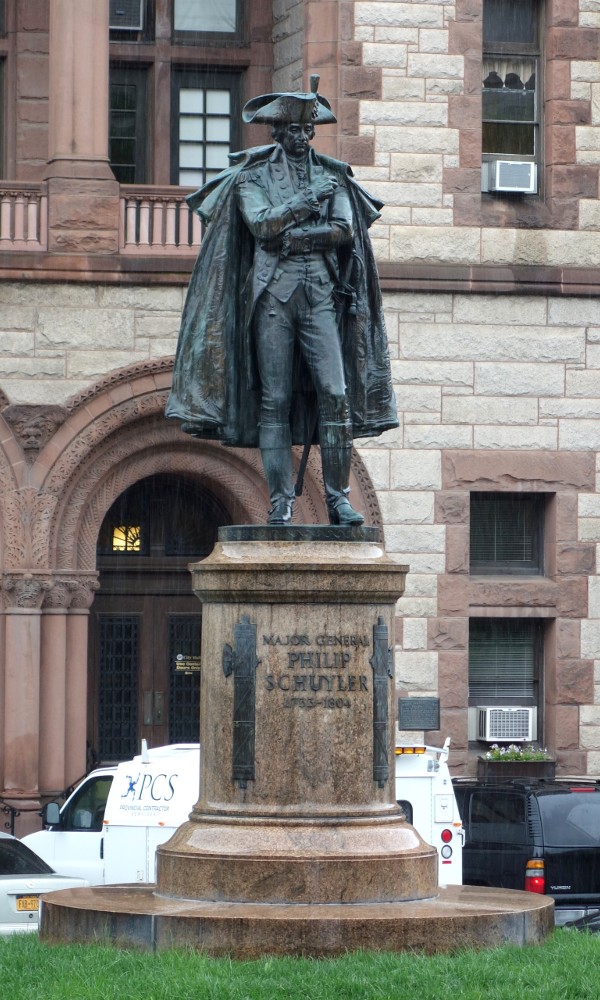The cast and crew of Hamilton are currently in the Capital Region for a 16-show run at Proctors that began March 14, and brought with them more than one reference to upstate New York. As most locals know, the play’s three-peas-in-a-pod “Schuyler Sisters” and their family were from Albany and led a privileged life in the area thanks to their father, Philip, a prominent politician and Army general. His presence is implied throughout the musical, although his character makes only one quick cameo—to give Founding Father Alexander Hamilton his blessing to marry his daughter Eliza.
In real life, that is of course but a footnote in the legacy of the famous patriot. The name “Schuyler” is one that Saratogians would have to work hard to miss. First, there’s the nearby Schuyler Mansion—where Eliza grew up with her parents and seven surviving siblings—that is now an official National Historic Landmark. Plus we’ve got the village of Schuylerville, our neighbor just 15 minutes to the east—and an almost 100-year-old statue of the man himself that remains at the center of a well-publicized and polarizing debate to this day.
Alas, Lin-Manuel Miranda’s Tony-winning master work is about the story of Hamilton, not Schuyler, leaving the latter’s history—both the good and bad—to us to share.

The historical evaluations of many of America’s founding patriots are complex and tend to ignite contentious debate and critical assessment. The life of Philip Schuyler is no exception. During his time, he was regarded as a popular and stalwart leader who fought for independence from an oppressive monarchy, but he simultaneously was one of New York’s most significant enslavers. This creates a great confliction in studying Schuyler, a man with a substantial record on opposite ends of an ideological spectrum that could not be further apart from a morality viewpoint.
Before Schuyler became one of the most notable figures in Saratoga County history, he was born into a prosperous family of Dutch heritage in 1733 and attended public school in Albany during his youth. As an adult, Schuyler’s notable military career that earned him so much acclaim kicked off when he fought for the British in the French and Indian War. He developed a provincial company—a regional troop of soldiers—and was commissioned as its captain by his cousin, New York Lieutenant Governor James Delancey. In 1756, the Albany native accompanied British officer John Bradstreet to Oswego, where he gained experience as a quartermaster. He also participated in the battles of Lake George, Oswego River and others. Following the war, Bradstreet sent Schuyler to England in 1760 to settle reimbursement claims for expenses incurred during the war effort.
But after what turned into a three-year job in England, the Capital Region beckoned.
After returning home to upstate New York, Schuyler took over the management of several farms and business enterprises, including a lucrative lumber venture in the Saratoga area and a flax mill—the first in the American colonies. He went on to become colonel and commander of a militia district regiment in 1767, and entered the budding nation’s political scene when he was elected to the New York General Assembly in 1768. He was eventually elected to the Continental Congress in 1775, the year in which the first shots of the American Revolution were fired.

Schuyler was prominent in preparing the American defense strategy during the Battles of Saratoga in 1777. (After all, he owned an estate in the area and had somewhat of a home-field advantage.) The British plan was to cut the colonies in two by invading and occupying the New York colony. So that summer, General John Burgoyne marched his British force from Canada, through the valleys of Lake Champlain and Lake George. On the journey, he took the small American garrison occupying Fort Ticonderoga between the two lakes. Following the abandonment of Ticonderoga by General Arthur St. Clair, Schuyler, being responsible for its defense, was accused of dereliction of duty and replaced by General Horatio Gates. In 1778, both Schuyler and St. Clair faced a court of inquiry over the loss of the fort; both were acquitted.
The British offensive continued on but was eventually stopped by the Continental Army, then under the command of Gates and Benedict Arnold (before he famously switched sides), at—you guessed it—Saratoga. That victory, the first overwhelming defeat of a large British force, is widely known as the turning point in the American Revolution, in large part because the outcome convinced France to enter the war on the American side.
Schuyler resigned from the Army in April 1779 and served two more sessions of the Continental Congress in 1779 and 1780. But it is what he did after the war that has ignited locals today.
Schuyler expanded his Saratoga estate in what’s now fittingly called Schuylerville to thousands of acres. The home had been destroyed by General Burgoyne’s Army in October 1777, and in rebuilding, Schuyler used enslaved people as laborers. The property included tenant farmers, a general store and mills for flour, flax and lumber. Schuyler also built several schooners on the Hudson River, the first of which he named Saratoga.
For most of the 1780s, Schuyler served in the New York State Senate. He went on to represent New York in the first United States Congress but, as Hamilton fans know, lost to young upstart Aaron Burr in New York’s 1791 State Senate election. Schuyler won election to the United States Senate again in 1797 as a member of the Federalist Party, but resigned a year later because of declining health. He died at the age of 70 at his Albany home on November 18, 1804, just four months after his son-in-law, Hamilton, was famously killed in a duel with Schuyler’s former political opponent, Burr.

Schuyler is buried at Albany Rural Cemetery in Menands and honored locally via the aforementioned almost-100-year-old statue that has been in the news since 2020. The statue’s controversy began four years prior, when the Schuyler Mansion State Historic Site published on its website that through “census records, receipts and Schuyler letters, we can piece together that between 8 and 13 people were enslaved under Philip Schuyler at the Albany estate over the years.” An additional population at Philip’s Saratoga estate brought the total to at least 30.
And thus, Albany Mayor Kathy Sheehan ordered Schuyler’s statue be removed from the front of City Hall, where it has resided for almost a century. The directive, one of many calls nationwide for the removal of statues of slave owners in recent years, was met with mixed reaction. The fate of the statue has yet to be decided, though possible sites for its relocation include the Schuyler Mansion Historic Site in Albany, the Schuyler family burial plot, and the Schuyler House on Route 4 in Saratoga County that is operated by the National Park Service. Meanwhile, Albany’s Philip J. Schuyler Achievement Academy, which serves primarily Black students, has started a process to change its name and disassociate itself from Schuyler, while the village of Schuylerville has resisted calls to change its name. “By no means do we condone or approve the owning of slaves,” Schuylerville Mayor Dan Carpenter has said. “However, there’s a steep tradition in history that our village has with General Schuyler.”
As time progresses and the perception of legacies of historical figures such as Philip Schuyler continue to evolve, one truth will remain: History—like the individuals who create it—will forever retain complexities and controversies. Or, as George Washington tells a young Hamilton in the musical written more than 200 years after his death, “History has its eyes on you.”


